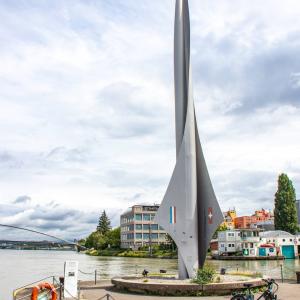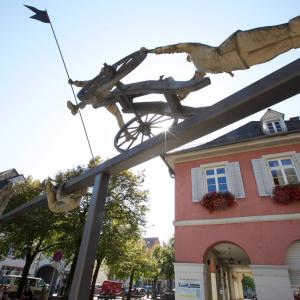History of the Three Countries
The Three Countries region was initially a natural area, with the Rhine at its heart, which favoured settlements and the establishment of an attractive region, rich in trade and exchange of goods and services.
The Three Countries Region, a Story of Borders
We can’t talk about the history of the Three Countries, without mentioning borders. It all begins at the Dreiländereck, a monument on the Basel side of the river, which marks the crossing point of the three borders in the middle of the Rhine, in the municipalities of Weil-am-Rhein, Huningue and the city of Basel. From here, going in three different directions, three borders, full of history.
The Birth of the Basel Canton
After the reform of the Holy Roman Empire in 1495, the Helvetic confederates began their conquest of the southern part of the Empire, moving up towards the Rhine. The treaty of Basel in 1499 was signed with the Empire, which recognised the existence of the independent Swiss cantons. This was how, on the 13th of July 1501, Basel became a canton and joined the Swiss Confederation.
A Region Impacted by Europe’s Games of Conquest
More than a century later, the Thirty Years’ War erupted in 1618 and destroyed the European continent. The Three Countries Region, at the strategic heart of the conflict, was ravaged. Famines and epidemics led to a sharp population decline. It was not until the end of this terrible conflict that the Treaties of Westphalia, signed in 1648, established a new border between France and the Holy Roman Empire: Alsace became French territory and Baden became German territory.
The European continent was then placed under the yoke of the Napoleonic conquests. Switzerland was invaded by France. The Basel canton became a French département: Mont Terrible, and was then incorporated into the Upper Rhine. Switzerland remained a French protectorate until 1813. It was not until the Treaties of Paris in 1814 and 1815 that the Franco-Swiss border was redefined: the bishopric of Basel became part of the Swiss Confederation. On the other side of the Rhine, the Grand Duchy of Baden and the Kingdom of Württemberg joined the German Confederation under the aegis of Prussia and Austria.
Did you know? In 1833, following a disagreement between Basel and its surrounding area, the canton of Basel became two independent cantons: Basel-City and Baselland.
The Famous Siege of Huningue
In 1815, after Napoléon’s surrender, Austrian troops besieged Huningue. This siege is famous because General Barbanègre held the town for two months with a few hundred men against thousands of Austrian soldiers. Louis XVIII ordered him to surrender. The famous fortifications of Huningue, built by Vauban on the orders of Louis XIV in 1679, were later dismantled. Today, only a few fragments remain.
The Wars of the 19th and 20th Centuries and the Redefinition of Borders
At the end of the 19th and start of the 20th centuries, Europe was shaken by war. The Three Borders area, representing a particular challenge as a border zone, became the scene of repeated fighting, massacres and annexations. Even if Switzerland remained neutral all this time, the Swiss border territory, and in particular the Basel region, hosted many displaced peoples.
At the end of the Franco-Prussian War (1870-1871), the Treaty of Frankfurt led to the annexation of Alsace-Moselle by the German Empire. The Franco-German border then moved up to Schlucht and, further south, up to the territory of Belfort. The Alsatians became Germans, with all that this implied: learning the language, applying new regulations and legislation, integrating into a new political system, even if for the most part, they retained a sentimental attachment to France.
In 1914 the First World War exploded. The civilian population of the region therefore experienced significant hardship. After the armistice, Alsace became French again, but the Alsatians of German origin found themselves in a complicated situation because the French government wanted to do away with the region's unique features (bilingualism etc.).
In 1940, after France’s defeat, Alsace and Moselle were annexed into the Nazi Third Reich, in contrast to France’s other territories, which were occupied. Those deemed “undesirable” by Nazi ideology were expelled, or in the worst cases, sent to concentration camps. Alsatians were therefore violently Germanised: being obliged to speak German, conscripted, and forced to join the Hitler Youth. It was not until the end of the Second World War, in 1945, that the Franco-German border as we know it today took shape.
Peace Followed War: The Emergence of a Trinational Region
The formation of the European Union led to a period of unification in the region leading to what we know today: a shared trinational region across borders. Since then, the Three Countries Region has been marked by the emergence of joint cross-border projects, and in particular by the increase in border crossings, and for our region specifically, the joint construction of bridges over the Rhine allowing populations to meet. The development of a culture of cross-border cooperation became a founding element of life in our trinational region.
The history of borders is not just a succession of wars, it has very concrete consequences on people, who have repeatedly experienced changes in nationality, culture and language. This has forged the unique character of this border region and made the Three Borders an endearing region that allows us to rediscover the great events of history, from a local and trinational perspective!






